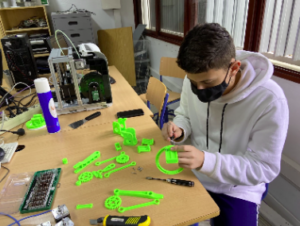
To create this module several teachers from the partner organizations have contributed with lesson design, testing, documentation, and evaluation of the activities. The participants involved are teaching a variety of subjects such as: Technology, CAD/CAM, Electronics, Programming, Electrical engineering. The participants have communicated through the project communication channel, on project meetings and online meetings, to divide tasks and to make sure that the thematic module is of good quality, comprehensive and that it contains units relevant to the theme.
More exact information on participation in the different activities can be found in each unit.
The thematic module consists of six units with mostly practical lessons. The units differ in size depending on the content and extent. Under each unit you will find instructions on how to carry out the included lessons and activities, as well as a description of the expected results and outcomes in the form of skills and competencies that the students are expected to develop.
The important context is that each unit is contributing towards thematic learning. The units in the thematic module can theoretically be used on their own, except for 3 units (Testing detector, Designing remote interface and Building and testing remote interface). Those units need to be used as a pack. They also need to be done in that order. As for the rest of the units they are related but not dependent on each other. The output of units goes towards building a finished product.
Sensor and sensor arm thematic module contains 6 units:
➡ Creation of a robotic arm
➡ Building and testing remote interface
➡ Implementation of metal detector with discrete components
Objectives of this thematic module
The objective of this thematic module is to prepare students for making complex project on their own and in particular:
Learn about 3D printers and printing materials, files for 3D printing, calibration of printer, how to adjust printer for printing and monitor it, assembling of printed product
Knowledge about how the product is tested, understanding of limitations of detector, technical skills to read and analyze a manual for a specific electrical device
Enhance skill in electrical device disassembly, knowledge of recognizing electrical components, knowledge of electronic circuits, skill in using prototyping boards, learn basic principles of electronic connections, knowledge of keyboards used to interface with microcontrollers, Knowledge of advanced electrical circuits, analogue and digital. Knowledge of designing electrical circuits in CAD software (schematics and PCBs). knowledge of electrical components, Knowledge of reading component datasheets
Knowledge of electrical components, Knowledge of reading datasheets, Knowledge of measuring and inspecting component physical and electrical properties, knowledge of soldering, knowledge of PCB inspection, Knowledge of proper connecting electrical devices to lab power supplies and measurement instruments, Knowledge on connecting FFC/FPC cable devices, mechanical skills for mounting and assembling two PCBs together. Basic programming skill in C on how to program I/O devices on a microcontroller.
The units are planned according to a common concept:
- Introduction: the problem is presented to students, and they are provided with all necessary information they need to solve the problem.
- Implementation: Students brainstorm the solutions for the task at hand. Teacher with all the students selects the solution that would work best.
- Finalization: the students present a final output for example in the form of a program, design or finished circuit board
Specific information about each unit, number of lessons, duration, output etcetera, can be found when you click on the units that you are interested in.
Teachers and collaborators of the thematic module
To create this module a number of teachers from the partner organisations have contributed with lesson design, testing, documentation and evaluation of the activities. The participants involved are teaching a variety of subjects such as: Technology, Electronics, Programming, 3D Printing, CAD Design, etc. The participants have communicated through the project communication channel, on project meetings and online meetings, to divide tasks and to make sure that the thematic module is of good quality, comprehensive and that it contains units relevant to the theme.
More exact information on participation in the different activities can be found in each unit.
